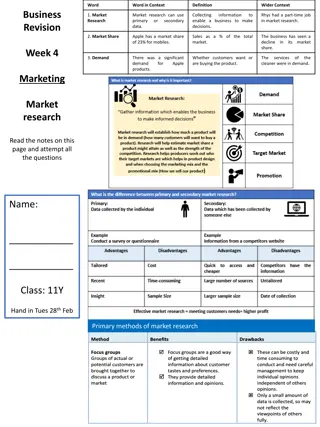
Market Structure and Strategy in Healthcare Organizations
Explore the societal and market factors influencing healthcare organizations, including the impact of technology and external environmental analysis. Learn about market structure, competitors, and strategic thinking for success in the healthcare industry.
Download Presentation

Please find below an Image/Link to download the presentation.
The content on the website is provided AS IS for your information and personal use only. It may not be sold, licensed, or shared on other websites without obtaining consent from the author. If you encounter any issues during the download, it is possible that the publisher has removed the file from their server.
You are allowed to download the files provided on this website for personal or commercial use, subject to the condition that they are used lawfully. All files are the property of their respective owners.
The content on the website is provided AS IS for your information and personal use only. It may not be sold, licensed, or shared on other websites without obtaining consent from the author.
E N D
Presentation Transcript
KING SAUD UNIVERSITY COLLEGE OF BUSINESS ADMINISTRATION DEPARTMENT OF HEALTHADMINISTRATION - MASTERS` PROGRAM 4/9/2025 PA 518 Strategic Management in Healthcare Organizations Second Semester 1436/ 1437 Mohammed S. Alnaif, Ph.D. E-mail: alnaif@ksu.edu.sa Mohammed Alnaif Ph.D.
UNDERSTANDING MARKET STRUCTURE AND STRATEGY Learning objectives Have an overview of the societal environment and its effect on the healthcare market, Recognize the effect of technology on the demand for and provision of healthcare, Know the components of an external environmental analysis, Understand the basic concepts of the market structure of an industry, Comprehend the principles of market position as it relates to market structure and competitors, and Be familiar with two methods of measuring market concentration. 4/9/2025 Mohammed Alnaif Ph.D.
UNDERSTANDING MARKET STRUCTURE AND STRATEGY Strategic Thinking All organizations operate in an open system that involves continuous interaction with an external environment that directly and indirectly influences their success. The external environment is made up of many components, including communities of people of different ages and cultures; governments and regulatory bodies; and competitive and collaborative industries and companies comprising numerous products, services, and providers. 4/9/2025 Mohammed Alnaif Ph.D.
UNDERSTANDING MARKET STRUCTURE AND STRATEGY Strategic Thinking These influences generally fall into one of two categories: 1. Societal factors and 2. Market factors. The context in which an organization operates heavily influences its strategies and its ability to achieve its mission and vision. Organizations developing a strategic direction must recognize and understand their external environment to be successful. 4/9/2025 Mohammed Alnaif Ph.D. 3. 4.
UNDERSTANDING MARKET STRUCTUREAND STRATEGY 4/9/2025 General Environment Mohammed Alnaif Ph.D. Healthcare Environment Internal Environment
4/9/2025 Mohammed Alnaif Ph.D.
4/9/2025 Mohammed Alnaif Ph.D.
4/9/2025 Mohammed Alnaif Ph.D.
UNDERSTANDING MARKET STRUCTURE AND STRATEGY Societal Environment The societal environment encompasses general economic conditions, population demographics, cultural values, governmental regulations, and technology. Healthcare is highly influenced by these factors. General economic conditions have a significant impact on healthcare. As economic conditions improve, people have more disposable income and insurance coverage, which can be used to obtain healthcare services. 4/9/2025 Mohammed Alnaif Ph.D.
UNDERSTANDING MARKET STRUCTURE AND STRATEGY Societal Environment Population demographics are also important in healthcare. Healthcare spending varies dramatically by age, race, and gender. People over age 65 spend three to five times more on healthcare than do those under age 65. Across the world, the number of individuals aged 65 or older is increasing dramatically. According to the Centers for Disease Control and Prevention (CDC 2003), from years 2000 to 2030 this population is projected to increase from 6.9 percent to 12.0 percent of the total population worldwide . 4/9/2025 Mohammed Alnaif Ph.D.
UNDERSTANDING MARKET STRUCTURE AND STRATEGY Societal Environment Consumption of healthcare varies by gender as well. Women use more healthcare services, including visits to primary care providers, emergency and diagnostic services, and specialty care, than men do (Bertakis et al. 2000). The number of females between ages 15 and 44 in the population affects birthrates; however, birthrates also are linked to economic and cultural factors. 4/9/2025 Mohammed Alnaif Ph.D.
UNDERSTANDING MARKET STRUCTURE AND STRATEGY Societal Environment To understand health issues in the external environment, healthcare organizations should identify their customers. Significant segments should be recognized and concentrations and trends examined. Data or spatial (geographic) analysis, such as a patient origin study, can be used to locate the communities in which customers reside and evaluate access to healthcare services . 4/9/2025 Mohammed Alnaif Ph.D.
UNDERSTANDING MARKET STRUCTURE AND STRATEGY Societal Environment In healthcare, the identification of intermediate organizations those between the patient and the provider is important. Patients may not have the freedom to select a provider of their choice. Physician practices and managed care contracts may significantly influence or direct where a patient goes for care. 4/9/2025 Mohammed Alnaif Ph.D.
UNDERSTANDING MARKET STRUCTURE AND STRATEGY Societal Environment Governmental regulations highly influence the healthcare field. Regulations require licensure, training, inspection, and approval of physicians and nurses, healthcare institutions, healthcare financiers, drug and medical products, research bodies, and public health agencies. 4/9/2025 Mohammed Alnaif Ph.D.
UNDERSTANDING MARKET STRUCTURE AND STRATEGY Societal Environment Technology also has a significant influence on healthcare. Advances in technology, including prescription drugs, have been identified as a leading contributor to the increase in overall healthcare spending. Medical technology is broadly defined as the procedures, equipment, and processes used to deliver medical care. 4/9/2025 Mohammed Alnaif Ph.D.
UNDERSTANDING MARKET STRUCTURE AND STRATEGY Societal Environment Examples are new medical and surgical procedures, such as implantation of cardiac defibrillators; new drugs; new medical devices; and new support systems. New technology can profoundly change the nature and process of care, which in turn may significantly influence organizations strategies. 4/9/2025 Mohammed Alnaif Ph.D.
UNDERSTANDING MARKET STRUCTURE AND STRATEGY Societal Environment Examples are new medical and surgical procedures, such as implantation of cardiac defibrillators; new drugs; new medical devices; and new support systems. New technology can profoundly change the nature and process of care, which in turn may significantly influence organizations strategies. 4/9/2025 Mohammed Alnaif Ph.D.
UNDERSTANDING MARKET STRUCTURE AND STRATEGY Market Structure Organizations exist in markets, a basic knowledge of the concept of market structure is important. To understand the principles of market structure, one first should learn the difference between industries and markets. Industries are particular categories of business or economic activities. They are composed of groups of sellers whose products are close substitutes. 4/9/2025 Mohammed Alnaif Ph.D.
UNDERSTANDING MARKET STRUCTURE AND STRATEGY Market Structure Market: A group of both sellers and buyers who exchange goods and services for a price. Market structure: Organizational characteristics of a market that exert a strategic influence on the intensity and form of competition. In markets, services and goods may be exchanged for other products and services (barter) or, more commonly, for money. 4/9/2025 Mohammed Alnaif Ph.D.
UNDERSTANDING MARKET STRUCTURE AND STRATEGY Market Structure There are four basic types of market structure, each of which reflects the number of organizations in the market and their degree of market influence: 1. Perfect competition 2. Monopolistic competition 3. Oligopoly 4. Monopoly 4/9/2025 Mohammed Alnaif Ph.D.
UNDERSTANDING MARKET STRUCTURE AND STRATEGY Perfect competition Exists when many small organizations produce an undifferentiated, homogeneous product. Consumers may struggle to differentiate the products in such markets, so organizations compete on the basis of price and seek low-cost production solutions. There are few barriers or impediments to entering the market, so new competitors move in and incumbents move out frequently. 4/9/2025 Mohammed Alnaif Ph.D.
UNDERSTANDING MARKET STRUCTURE AND STRATEGY Perfect competition In ideal perfect competition, consumers have enough information to make informed choices, and the prices they pay are close to production costs. Gasoline, generic drugs, currency markets, and agricultural commodities (e.g., wheat, rice, and corn) are examples of markets that closely approach perfect competition. Because consumers often fail to distinguish companies products in such markets, price often drives consumers purchasing decisions. Therefore, low cost is the primary strategic focus in perfect competition. 4/9/2025 Mohammed Alnaif Ph.D.
UNDERSTANDING MARKET STRUCTURE AND STRATEGY 4/9/2025 Monopolistic Competition Similar to perfect competition, monopolistic competition is a market involving many organizations. However, this structural type differentiates its products, so differentiation is the organizations strategic focus; they seek to distinguish their products from competitors. Differentiation can be achieved by offering products with better features, enhancing service, employing more helpful and friendly personnel, boosting distribution channel performance, or improving one s image. Mohammed Alnaif Ph.D.
UNDERSTANDING MARKET STRUCTURE AND STRATEGY 4/9/2025 Monopolistic Competition Many products are available to consumers, and competition increases as products and their perceived quality become more diversified. Competition is typically vigorous in monopolistic competition. However, each organization, depending on its degree of differentiation, has some control over the prices of its products. Organizations with greater product differentiation have more power to raise prices over those of their competitors.. Mohammed Alnaif Ph.D.
UNDERSTANDING MARKET STRUCTURE AND STRATEGY Monopolistic Competition 4/9/2025 Entry into and exit from monopolistic competition is easy. Restaurants, manufacturers of breakfast cereals, and most private physician services operate in monopolistic competition structures. Mohammed Alnaif Ph.D. In the case of private physician services, for instance, physicians differentiate themselves by office location, specialization, and personal relationships with their patients. Because of these and other factors, price generally is not a major consideration when people are choosing physicians.
UNDERSTANDING MARKET STRUCTURE AND STRATEGY Oligopoly Oligopolies are market structures dominated by a few large organizations that offer similar or identical products. Organizations in oligopolies focus their strategies on capturing market share, unless they can collude to increase profits by fixing prices or reducing supplies. A global example of collusion by organizations in an oligopoly is the formation of the Organization of Petroleum Exporting Countries (OPEC). In 1960, the large oil producers banded together to restrict the supply and raise the price of oil . 4/9/2025 Mohammed Alnaif Ph.D.
UNDERSTANDING MARKET STRUCTURE AND STRATEGY Oligopoly Organizations seeking to enter or exit an oligopoly face substantial barriers. The cost of entry is often great, and the specialized nature of business in oligopolies makes leaving difficult. Consumers have limited choices because the producers of a product or service are limited in number, and buyers often choose services or products on the basis of location or personal preference. 4/9/2025 Mohammed Alnaif Ph.D.
UNDERSTANDING MARKET STRUCTURE AND STRATEGY Oligopoly 4/9/2025 For instance, the construction of a new tertiary hospital may cost millions of dollars, require multiple permits, change referral patterns, and necessitate hiring a medical staff. Mohammed Alnaif Ph.D. Therefore, generally few tertiary hospitals compete in a market. Patients have limited choices for tertiary care. They may choose the tertiary hospital closest to their home, referred by their insurance company, or preferred by their personal physician.
UNDERSTANDING MARKET STRUCTURE AND STRATEGY Oligopoly 4/9/2025 Examples of oligopolies in healthcare include tertiary hospitals, healthcare insurance companies, drug companies, and group purchasing organizations. Mohammed Alnaif Ph.D. Non-healthcare oligopolies include airline, steel, aluminum, automobile, oil, tire, and soft drink companies.
UNDERSTANDING MARKET STRUCTURE AND STRATEGY Monopoly Monopolies, on the other hand, involve just one organization. As a result, the monopolist has the power to control the type and quality of products and services provided. Competition is almost nonexistent, so the monopolist spends much of its time and strategic efforts creating and maintaining barriers to keep potential competitors out of its market. The service customers receive is often expensive and of marginal or poor quality. 4/9/2025 Mohammed Alnaif Ph.D.
UNDERSTANDING MARKET STRUCTURE AND STRATEGY Monopoly 4/9/2025 For example, in one Middle Eastern country where the cell phone service used to be a monopoly, customers had to pay about $2,750 to obtain a cell phone and then wait for three months for the service to be activated. Mohammed Alnaif Ph.D. Calls were frequently dropped, and customer service was terrible. After opening the market to other phone companies, initiation fees disappeared, costs plummeted, and services dramatically improved.
UNDERSTANDING MARKET STRUCTURE AND STRATEGY Monopoly 4/9/2025 Prices appear higher in monopolistic conditions in other healthcare sectors as well. Mohammed Alnaif Ph.D. Studies have suggested that markets with high hospital concentration (near- monopoly conditions) charge higher prices. Examples of monopolies include many rural hospitals, new drugs under patent, utility companies, and the National Foot- ball League.
UNDERSTANDING MARKET STRUCTURE AND STRATEGY Monopoly 4/9/2025 Because of the influence concentrated markets (monopolies and oligopolies) have on price and supply, many governments have passed antitrust laws to restrict the market share organizations may have and curb potential predatory behavior. Mohammed Alnaif Ph.D.
EXHIBIT 2.9 GRAPHICALLYDISPLAYSTHEFOURMARKETTYPES ANDTHEIRRELATIONSHIPTOTHENUMBEROFCOMPETITORSAND COMPETITORS DEGREEOFMARKETINFLUENCE 4/9/2025 None Total Mohammed Alnaif Ph.D. Degree of Market Influence Perfect competition Oligopoly Monopoly Monopolistic competition Number of Competitors Many One
UNDERSTANDING MARKET STRUCTURE AND STRATEGY Product life Cycle Markets also tend to go through cyclical changes. Most products and services go through phases or a life cycle that relates to the rate of sales, number of organizations in the market, and consumer demand. The product life cycle has been seen as a useful framework for analyzing dynamic market conditions and applying more relevant, appropriate strategic alternatives. 4/9/2025 Mohammed Alnaif Ph.D.
THEPRODUCTLIFECYCLEISTYPICALLYDEPICTEDASFOUR STAGES: EMERGING, GROWTH, MATURITY, ANDDECLINE. 4/9/2025 Mohammed Alnaif Ph.D.
UNDERSTANDING MARKET STRUCTURE AND STRATEGY Product life Cycle The product life cycle, although helpful in strategic thinking, has some limitations as a framework for analysis. The S curve is not necessarily a sequential function. Some products skip stages or move back to a previous stage when new markets are created, new uses for the products are discovered, or technology advances. In addition, the duration of each stage and of the transition to another stage is unpredictable. Fad products might grow rapidly, while durable products may experience extended, slow growth. 4/9/2025 Mohammed Alnaif Ph.D.
UNDERSTANDING MARKET STRUCTURE AND STRATEGY Product life Cycle For instance, the sales of Procter & Gamble s laundry detergent Tide grew consistently from its introduction in 1947 through 1976. Over that period, the formula was modified 55 times to better match consumer preferences. On the other hand, product life cycles are extremely short in the semiconductor, computer, and telecommunication industries today due to constantly changing technologies and consumer demand. 4/9/2025 Mohammed Alnaif Ph.D.
4/9/2025 Mohammed Alnaif Ph.D. THANK YOU





















